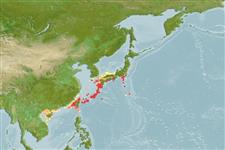>
Eupercaria/misc (Various families in series Eupercaria) >
Labridae (Wrasses) > Corinae
Etymology: Halichoeres: Greek, als, alis = salt + Greek, choiros = pig (Ref. 45335); orientalis: Named in reference to its occurrence in southern Japan and Taiwan (Ref. 31549).
More on author: Randall.
Environment: milieu / climate zone / depth range / distribution range
Ecologie
marien rifbewoner; diepte 2 - 30 m (Ref. 31549). Subtropical
Northwest Pacific: southern Japan and Taiwan.
Grootte / Gewicht / Leeftijd
Maturity: Lm ? range ? - ? cm
Max length : 7.6 cm SL mannelijk / geslacht onbekend; (Ref. 31549)
Korte beschrijving
Determinatiesleutels | Morfologie | Morfometrie
Dorsale stekels (totaal) : 9; Dorsale zachte stralen (totaal) : 12; Anale stekels: 3; Anale zachte stralen: 12; Wervels: 25. Each lateral line scale with 2-4 tubules; without scales on cheek or opercle; without scales basally on dorsal or anal fins; a single pair of stout canines anteriorly in each jaw; a strong canine at corner of mouth; 9th dorsal spine longest, 2.75-3.1 in HL; green with 4 longitudinal salmon pink to orange bands on head, the 2nd and 3rd passing through eye, the 3rd bifurcating on opercle; a small vertically elongate black spot behind eye; upper 3 bands of head continuing as stripes anteriorly on body, and 2 more commencing from beneath pectoral fin, these stripes variously breaking into segments and forming 6 groups of irregular spots dorsally on body, the 2nd group in a dusky blotch; presumed male with this blotch black and containing small irregularly yellow spots; another presumed male phase blackish posteriorly to a vertical through base of 6th dorsal spine.
Levenscyclus en paargedrag
Maturities | Voortplanting | Spawnings | Egg(s) | Fecundities | Larven
Distinct pairing during breeding (Ref. 205).
Randall, J.E., 1999. Halichoeres orientalis, a new labrid fish from southern Japan and Taiwan. Zool. Stud. 38(3):295-300. (Ref. 31549)
Status op de Rode Lijst van het IUCN (Ref. 130435)
Gevaar voor de mens
Harmless
Gebruik door de mens
Tools
Speciale rapporten
Download XML
Internetbronnen
Estimates based on models
Preferred temperature (Ref.
123201): 21.4 - 27.1, mean 24.9 °C (based on 176 cells).
Fylogenetische diversiteitsindex (Ref.
82804): PD
50 = 0.5000 [Uniqueness, from 0.5 = low to 2.0 = high].
Bayesian length-weight: a=0.00955 (0.00451 - 0.02020), b=3.09 (2.92 - 3.26), in cm total length, based on LWR estimates for this Genus-body shape (Ref.
93245).
Trofisch niveau (Ref.
69278): 3.3 ±0.5 se; based on size and trophs of closest relatives
Weerstandsvermogen (Ref.
120179): Hoog, minimale populatieverdubbelingstijd minder dan 15 maanden (Preliminary K or Fecundity.).
Fishing Vulnerability (Ref.
59153): Low vulnerability (10 of 100).
Nutrients (Ref.
124155): Calcium = 86 [38, 193] mg/100g; Iron = 0.886 [0.457, 1.899] mg/100g; Protein = 19 [16, 21] %; Omega3 = 0.265 [0.138, 0.510] g/100g; Selenium = 10.1 [4.3, 22.6] μg/100g; VitaminA = 113 [30, 544] μg/100g; Zinc = 1.48 [0.87, 2.62] mg/100g (wet weight);
